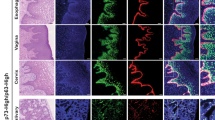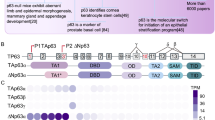Abstract
p63 and p73 show a high degree of structural homology to p53 and are members of a family of transcriptional factors that can activate transcription of p53-responsive genes. p53 is mutated in more than 50% of human cancers, whereas p63 and p73 are rarely mutated. Studies of knockout mice also revealed an unexpected functional diversity among the p53 family. To determine how p63 and p73 are involved in tumorigenesis and normal development, we used cDNA microarray to examine 9216 genes in human colorectal cancer cells. We discovered that the expression of pigment epithelium-derived factor (PEDF) was specifically induced by either p63 or p73, but not by p53. We also report here that the PEDF gene contains a response element specific for p63 and p73 in its promoter region and is a direct target of p63 and p73. Collectively, p63 and p73 may be involved in cell fate by inducing PEDF expression.
This is a preview of subscription content, access via your institution
Access options
Subscribe to this journal
Receive 50 print issues and online access
$259.00 per year
only $5.18 per issue
Buy this article
- Purchase on Springer Link
- Instant access to full article PDF
Prices may be subject to local taxes which are calculated during checkout



Similar content being viewed by others
References
Becerra SP, Sagasti A, Spinella P and Notario V . (1995). J. Biol. Chem., 270, 25992–25999.
Billon N, Terrinoni A, Jolicoeur C, McCarthy A, Richardson WD, Melino G and Raff M . (2004). Development, 131, 1211–1220.
Carmeliet P and Jain RK . (2000). Nature, 407, 249–257.
Crawford SE, Stellmach V, Ranalli M, Huang X, Huang L, Volpert O, De Vries GH, Abramson LP and Bouck N . (2001). J. Cell Sci., 114, 4421–4428.
Dawson DW, Volpert OV, Gillis P, Crawford SE, Xu H, Benedict W and Bouck NP . (1999). Science, 285, 245–248.
De Laurenzi V, Raschella G, Barcaroli D, Annicchiarico-Petruzzelli M, Ranalli M, Catani MV, Tanno B, Costanzo A, Levrero M and Melino G . (2000a). J. Biol. Chem., 275, 15226–15231.
De Laurenzi V, Rossi A, Terrinoni A, Barcaroli D, Levrero M, Costanzo A, Knight RA, Guerrieri P and Melino G . (2000b). Biochem. Biophys. Res. Commun., 273, 342–346.
Dietz S, Rother K, Bamberger C, Schmale H, Mossner J and Engeland K . (2002). FEBS. Lett., 525, 93–99.
Doll JA, Stellmach VM, Bouck NP, Bergh AR, Lee C, Abramson LP, Cornwell ML, Pins MR, Borensztajn J and Crawford SE . (2003). Nat. Med., 9, 774–780.
Donehower LA, Harvey M, Slagle BL, McArthur MJ, Montgomery Jr CA, Butel JS and Bradley A . (1992). Nature, 356, 215–221.
El-Deiry WS, Kern SE, Pietenpol JA, Kinzler KW and Vogelstein B . (1992). Nat. Genet., 1, 45–49.
El-Deiry WS . (1998). Semin. Cancer Biol., 8, 345–357.
Hainaut P, Soussi T, Shomer B, Hollstein M, Greenblatt M, Hovig E, Harris CC and Montesano R . (1997). Nucleic Acids Res., 25, 151–157.
Hollstein M, Soussi T, Thomas G, von Brevern MC and Bartsch . (1997). Recent Results Cancer Res., 143, 369–389.
Holmgren L, O'Reilly MS and Folkman J . (1995). Nat. Med., 1, 149–153.
Ishida S, Yamashita T, Nakaya U and Tokino T . (2000). Jpn. J. Cancer Res., 91, 174–180.
Jost CA, Marin MC and Kaelin Jr WG . (1997). Nature, 389, 191–194.
Kaghad M, Bonnet H, Yang A, Creancier L, Biscan JC, Valent A, Minty A, Chalon P, Lelias JM, Dumont X, Ferrara P, McKeon F and Caput D . (1997). Cell, 90, 809–819.
Melino G, De Laurenzi V and Vousden KH . (2002). Nat. Rev. Cancer, 2, 605–615.
Melino G, Lu X, Gasco M, Crook T and Knight RA . (2003). Trends Biochem. Sci., 28, 663–670.
Mills AA, Zheng B, Wang XJ, Vogel H, Roop DR and Bradley A . (1999). Nature, 398, 708–713.
Morimoto I, Sasaki Y, Ishida S, Imai K and Tokino T . (2002). Genes Chromosomes Cancer, 33, 270–278.
Okabe H, Satoh S, Kato T, Kitahara O, Yanagawa R, Yamaoka Y, Tsunoda T, Furukawa Y and Nakamura Y . (2001). Cancer Res., 61, 2129–2137.
Ono K, Tanaka T, Tsunoda T, Kitahara O, Kihara C, Okamoto A, Ochiai K, Takagi T and Nakamura Y . (2000). Cancer Res., 60, 5007–5011.
Osada M, Ohba M, Kawahara C, Ishioka C, Kanamaru R, Katoh I, Ikawa Y, Nimura Y, Nakagawara A, Obinata M and Ikawa S . (1998). Nat. Med., 4, 839–843.
Prabhu NS, Somasundaram K, Satyamoorthy K, Herlyn M and El-Deiry WS . (1998). Int. J. Oncol., 13, 5–9.
Sasaki Y, Morimoto I, Ishida S, Yamashita T, Imai K and Tokino T . (2001). Gene Therapy, 8, 1401–1408.
Sasaki Y, Ishida S, Morimoto I, Yamashita T, Kojima T, Kihara C, Tanaka T, Imai K, Nakamura Y and Tokino T . (2002). J. Biol. Chem., 277, 719–724.
Sasaki Y, Mita H, Toyota M, Ishida S, Morimoto I, Yamashita T, Tanaka T, Imai K, Nakamura Y and Tokino T . (2003). Cancer Res., 63, 8145–8152.
Stellmach V, Crawford SE, Zhou W and Bouck N . (2001). Proc. Natl. Acad. Sci. USA, 98, 2593–2597.
Taniwaki T, Becerra SP, Chader GJ and Schwartz JP . (1995). J. Neurochem., 64, 2509–2517.
Tokino T and Nakamura Y . (2000). Crit. Rev. Oncol. Hematol., 33, 1–6.
Tombran-Tink J, Chader GG and Johnson LV . (1991). Exp. Eye Res., 53, 411–414.
van Bokhoven H and Mckeon F . (2002). Trends Mol. Med., 8, 133–139.
Vogelstein B, Lane D and Levine AJ . (2000). Nature, 408, 307–310.
Yang A, Kaghad M, Wang Y, Gillett E, Fleming MD, Dotsch V, Andrews NC, Caput D and McKeon F . (1998). Mol. Cell, 2, 305–316.
Yang A, Schweitzer R, Sun D, Kaghad M, Walker N, Bronson RT, Tabin C, Sharpe A, Caput D, Crum C and McKeon F . (1999). Nature, 398, 714–718.
Yang A, Walker N, Bronson R, Kaghad M, Oosterwegel M, Bonnin J, Vagner C, Bonnet H, Dikkes P, Sharpe A, McKeon F and Caput D . (2000). Nature, 404, 99–103.
Yang A, Kaghad M, Caput D and McKeon F . (2002). Trends Genet., 18, 90–95.
Zheng X and Chen X . (2001). FEBS Lett., 489, 4–7.
Acknowledgements
We thank Dr Joseph F Costello for valuable discussion in this study. This study was supported in part by Grants-in-Aid for Scientific Research on Priority Areas from the Ministry of Education, Culture, Sports, Science and Technology (YS, KI and TT).
Author information
Authors and Affiliations
Corresponding author
Rights and permissions
About this article
Cite this article
Sasaki, Y., Naishiro, Y., Oshima, Y. et al. Identification of pigment epithelium-derived factor as a direct target of the p53 family member genes. Oncogene 24, 5131–5136 (2005). https://doi.org/10.1038/sj.onc.1208695
Received:
Revised:
Accepted:
Published:
Issue Date:
DOI: https://doi.org/10.1038/sj.onc.1208695
Keywords
This article is cited by
-
A balancing act: orchestrating amino-truncated and full-length p73 variants as decisive factors in cancer progression
Oncogene (2015)
-
Forkhead transcription factor FOXF1 is a novel target gene of the p53 family and regulates cancer cell migration and invasiveness
Oncogene (2014)
-
The effects of PEDF on cancer biology: mechanisms of action and therapeutic potential
Nature Reviews Cancer (2013)
-
‘Loss of pigment epithelium-derived factor enables migration, invasion and metastatic spread of human melanoma’
Oncogene (2009)
-
p53 and ΔNp63α differentially bind and regulate target genes involved in cell cycle arrest, DNA repair and apoptosis
Oncogene (2007)



